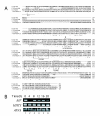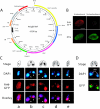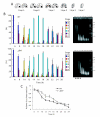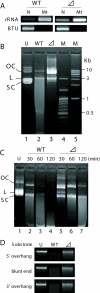Role of apoptosis-inducing factor (AIF) in programmed nuclear death during conjugation in Tetrahymena thermophila
- PMID: 20146827
- PMCID: PMC2829475
- DOI: 10.1186/1471-2121-11-13
Role of apoptosis-inducing factor (AIF) in programmed nuclear death during conjugation in Tetrahymena thermophila
Abstract
Background: Programmed nuclear death (PND), which is also referred to as nuclear apoptosis, is a remarkable process that occurs in ciliates during sexual reproduction (conjugation). In Tetrahymena thermophila, when the new macronucleus differentiates, the parental macronucleus is selectively eliminated from the cytoplasm of the progeny, concomitant with apoptotic nuclear events. However, the molecular mechanisms underlying these events are not well understood. The parental macronucleus is engulfed by a large autophagosome, which contains numerous mitochondria that have lost their membrane potential. In animals, mitochondrial depolarization precedes apoptotic cell death, which involves DNA fragmentation and subsequent nuclear degradation.
Results: We focused on the role of mitochondrial apoptosis-inducing factor (AIF) during PND in Tetrahymena. The disruption of AIF delays the normal progression of PND, specifically, nuclear condensation and kilobase-size DNA fragmentation. AIF is localized in Tetrahymena mitochondria and is released into the macronucleus prior to nuclear condensation. In addition, AIF associates and co-operates with the mitochondrial DNase to facilitate the degradation of kilobase-size DNA, which is followed by oligonucleosome-size DNA laddering.
Conclusions: Our results suggest that Tetrahymena AIF plays an important role in the degradation of DNA at an early stage of PND, which supports the notion that the mitochondrion-initiated apoptotic DNA degradation pathway is widely conserved among eukaryotes.
Figures







Similar articles
-
Ran1 is essential for parental macronuclear import of apoptosis-inducing factor and programmed nuclear death in Tetrahymena thermophila.FEBS J. 2019 Mar;286(5):913-929. doi: 10.1111/febs.14761. Epub 2019 Feb 4. FEBS J. 2019. PMID: 30663224
-
A novel mitochondrial nuclease-associated protein: a major executor of the programmed nuclear death in Tetrahymena thermophila.Biol Cell. 2014 Mar;106(3):97-109. doi: 10.1111/boc.201300037. Epub 2014 Feb 6. Biol Cell. 2014. PMID: 24392831
-
A possible role of mitochondria in the apoptotic-like programmed nuclear death of Tetrahymena thermophila.FEBS J. 2005 Oct;272(20):5378-87. doi: 10.1111/j.1742-4658.2005.04936.x. FEBS J. 2005. PMID: 16218967
-
Does apoptosis-inducing factor (AIF) have both life and death functions in cells?Bioessays. 2006 Aug;28(8):834-43. doi: 10.1002/bies.20444. Bioessays. 2006. PMID: 16927311 Review.
-
The oxido-reductase activity of the apoptosis inducing factor: a promising pharmacological tool?Curr Pharm Des. 2013;19(14):2628-36. doi: 10.2174/1381612811319140012. Curr Pharm Des. 2013. PMID: 23116400 Review.
Cited by
-
Atg5 Regulates Selective Autophagy of the Parental Macronucleus during Tetrahymena Sexual Reproduction.Cells. 2021 Nov 8;10(11):3071. doi: 10.3390/cells10113071. Cells. 2021. PMID: 34831293 Free PMC article.
-
Sirtuin-mediated nuclear differentiation and programmed degradation in Tetrahymena.BMC Cell Biol. 2011 Sep 21;12:40. doi: 10.1186/1471-2121-12-40. BMC Cell Biol. 2011. PMID: 21933443 Free PMC article.
-
A comparative in-silico analysis of autophagy proteins in ciliates.PeerJ. 2017 Jan 17;5:e2878. doi: 10.7717/peerj.2878. eCollection 2017. PeerJ. 2017. PMID: 28123910 Free PMC article.
-
Ancestral State Reconstruction of the Apoptosis Machinery in the Common Ancestor of Eukaryotes.G3 (Bethesda). 2018 May 31;8(6):2121-2134. doi: 10.1534/g3.118.200295. G3 (Bethesda). 2018. PMID: 29703784 Free PMC article.
-
Autophagy in protists and their hosts: When, how and why?Autophagy Rep. 2023;2(1):2149211. doi: 10.1080/27694127.2022.2149211. Epub 2023 Mar 9. Autophagy Rep. 2023. PMID: 37064813 Free PMC article.
References
Publication types
MeSH terms
Substances
LinkOut - more resources
Full Text Sources

